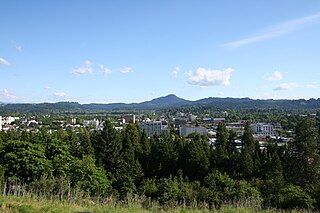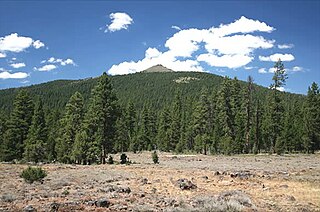
The McKenzie River is a 90-mile (145 km) tributary of the Willamette River in western Oregon in the United States. It drains part of the Cascade Range east of Eugene and flows westward into the southernmost end of the Willamette Valley. It is named for Donald McKenzie, a Scottish Canadian fur trader who explored parts of the Pacific Northwest for the Pacific Fur Company in the early 19th century. As of the 21st century, six large dams have been built on the McKenzie and its tributaries.

The Illinois River is a tributary, about 56 miles (90 km) long, of the Rogue River in the U.S. state of Oregon. It drains part of the Klamath Mountains in northern California and southwestern Oregon. The river's main stem begins at the confluence of its east and west forks near Cave Junction in southern Josephine County. Its drainage basin includes Sucker Creek, which rises in the Red Buttes Wilderness, near Whiskey Peak on the California state line. The main stem flows generally northwest in a winding course past Kerby and through the Siskiyou National Forest and Kalmiopsis Wilderness. It joins the Rogue River from the south at Agness on the Curry–Josephine county line, 27 miles (43 km) from the Pacific Ocean.

The Three Sisters Wilderness is a wilderness area in the Cascade Range, within the Willamette and Deschutes National Forests in Oregon, United States. It comprises 286,708 acres (1,160.27 km2), making it the second largest wilderness area in Oregon, after the Eagle Cap Wilderness. It was established by the United States Congress in 1964 and is named for the Three Sisters volcanoes. The wilderness boundary encloses the Three Sisters as well as Broken Top, which is southeast of South Sister.

The Oregon Historical Society(OHS) is an organization that encourages and promotes the study and understanding of the history of the Oregon Country, within the broader context of U.S. history. Incorporated in 1898, the Society collects, preserves, and makes available materials of historical character and interest, and collaborates with other groups and individuals with similar aims. The society operates the Oregon History Center that includes the Oregon Historical Society Museum in downtown Portland.

The Siltcoos River is a 3-mile (4.8 km) stream on the central coast of the U.S. state of Oregon. It begins at Siltcoos Lake, which straddles the border between Douglas and Lane counties. The river meanders generally west to the Pacific Ocean. It is located about 8 miles (13 km) south of Florence and 13 miles (21 km) north of Reedsport. The river, losing little elevation between source and mouth, passes through the Westlake section of Dunes City, under U.S. Route 101, and through a marshy area and sand dunes of Oregon Dunes National Recreation Area, which is within Siuslaw National Forest.

Spencer Butte is a prominent landmark in Lane County, Oregon, United States, described in the National Geodetic Survey as "a prominent timbered butte with a bare rocky summit" on the southern edge of Eugene, with an elevation of 2,058 feet (627 m). Spencer Butte is accessible from Spencer Butte Park and has several hiking trails to the summit. The tree cover on the butte is predominantly Douglas fir, however the butte is treeless at its summit. The butte is the tallest point visible when looking south from downtown Eugene.

Strawberry Lake is a natural high-elevation body of water in the Strawberry Mountain Wilderness in the U.S. state of Oregon. Located about 10 miles (16 km) south of Prairie City in Grant County, the shallow lake covers about 36 acres (150,000 m2) surrounded by forest. Recreational activities in the lake basin include hiking, backpacking, skiing, and fishing.

The Bulletin is the daily newspaper of Bend, Oregon, United States. The Bulletin is owned by EO Media Group, which prior to January 2013 was named the East Oregonian Publishing Company. Over the years, a number of well-known journalists have been associated with the newspaper.

Pilot Rock is a prominent volcanic plug located in the western Cascade Range near the east end of the Siskiyou Mountains, just east of the Siskiyou Summit near Ashland, Oregon. Rising thousands of feet above the Shasta and Rogue valleys, it is a landmark distinguishable from over 40 miles (64 km) away. At 25.6 million years old, it is one of the oldest formations of the Cascade Range. The rock is protected by the Cascade–Siskiyou National Monument and the Soda Mountain Wilderness. Several trails pass near Pilot Rock, including the Pacific Crest Trail.

Philip Francis Brogan was an Oregon journalist and author. He was a reporter, writer, and editor for the Bend Bulletin for 44 years, earning numerous awards for his work. He was also a well known historian, geologist, paleontologist, geographer, meteorologist, astronomer, and outdoorsman. He served as president of the Oregon Geographic Names Board for over twenty years. Brogan wrote East of the Cascades in 1964, an important source of information on the geology, geography, and history of Central Oregon. Phil Brogan Viewpoint near Lava Butte in Newberry National Volcanic Monument is named in his honor.

Binford & Mort Publishing is a book publishing company located in Hillsboro, Oregon, United States. Founded in 1930, the company was previously known as Metropolitan Press and Binfords & Mort. At one time they were the largest book publisher in the Pacific Northwest. The privately owned company focuses on books from the Pacific Northwest, and has printed many important titles covering Oregon's history.

The French Pete Trail is a 9.9-mile (15.9 km) hiking trail in the valley of French Pete Creek in the Three Sisters Wilderness of western Oregon. The trail passes through low-elevation old-growth forest that was a nationwide political issue in the 1960s and 1970s because of conflicting plans for logging and for wilderness designation, respectively. In 1978, the U.S. Congress passed a bill adding the French Pete area to the Three Sisters Wilderness.

Derrick Cave is a lava tube located in the remote northwest corner of Lake County, Oregon. The cave is approximately 1,200 feet (370 m) long. It is up to 80 feet (24 m) wide and 46 feet (14 m) high in places. It was named in honor of H.E. Derrick, a pioneer rancher with a homestead 3 miles (4.8 km) southeast of the cave. The land around the cave is managed by the United States Department of Interior, Bureau of Land Management. Derrick Cave is open to the public year-round; however, camping is no longer permitted in the cave.

Elliott Corbett Memorial State Recreation Site is a state park along the south shore of Blue Lake Crater in Jefferson County, Oregon, United States. The park is named in honor of Elliott R. Corbett II, who was killed while serving in the United States Army during World War II. It includes 63 acres (25 ha) of wilderness land with very few park facilities. Corbett State Park is administered by the Oregon Parks and Recreation Department.

The Frank E. Beach Memorial Fountain, officially titled Water Sculpture, is an abstract 1975 stainless steel fountain and sculpture by artist Lee Kelly and architect James Howell, installed in Washington Park's International Rose Test Garden in Portland, Oregon. The memorial commemorates Frank E. Beach, who christened Portland the "City of Roses" and proposed the Rose Festival. It was commissioned by the Beach family and cost approximately $15,000. Previously administered by the Metropolitan Arts Commission, the work is now part of the City of Portland and Multnomah County Public Art Collection courtesy of the Regional Arts & Culture Council.

Hager Mountain is a volcanic peak in Oregon in the northwest corner of the Basin and Range Province in the United States. The mountain is located south of the small unincorporated community of Silver Lake in south-central Oregon, and it is in the Fremont–Winema National Forest. On the summit, there is a fire lookout operated during the summer and fall by the United States Forest Service. There are several hiking trails that lead to the lookout station.

A bronze sculpture of American pioneer, newspaper editor and historian Harvey W. Scott (1838–1910) by Gutzon Borglum, sometimes called Harvey Scott or Harvey W. Scott, was installed on Mount Tabor in Portland, Oregon, United States, until being toppled in October 2020.

The Cline Buttes are mountains with volcanic origins that form three dome-shaped peaks located in Deschutes County in central Oregon. They are some of the eastern foothills of the Cascade Range. Situated on land administered by the Bureau of Land Management, the buttes are flanked on the east and west sides by two separate sections of the Eagle Crest Resort. On the highest summit, there is a Federal Aviation Administration site with an aircraft navigation beacon. The mountains have several hiking trails as well as a number of popular mountain bike routes.

Leslie Allen Joslin is an American retired naval officer, natural resource manager, educator, and author. After serving twenty-two years in the United States Navy, Joslin retired in Oregon where he worked for the United States Forest Service. He also taught college courses at Central Oregon Community College and Oregon State University. Joslin has written or edited eleven books, most of them related in some way to the Forest Service or the state of Oregon. He is also a well-known lecturer on forest resources and central Oregon history topics.



















